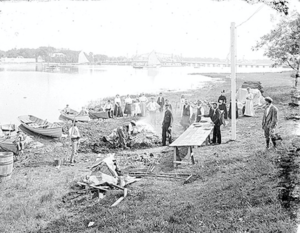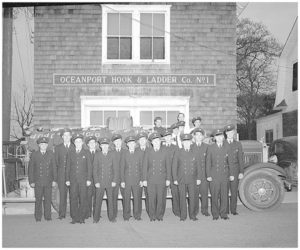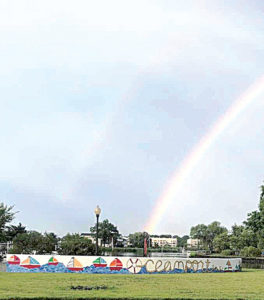By Judy O’Gorman Alvarez
OCEANPORT – One hundred years is an important milestone for a town and big plans were in place for Oceanport’s celebration this year. But even though the coronavirus pandemic interfered, this 3.2-square-mile borough of nearly 6,000 residents has a way of pivoting and adapting to change – something it’s proven over the last century.

Just as they’ve been doing for, well, 100 years or so, borough residents are once again shifting, first from agriculture to shipping in the 1800s, then to horse racing and now the redevelopment of its portion of Fort Monmouth.
Celebration Plans on Hold
The borough’s historical committee had been busy planning events, most of which have been shelved. Those included a Centennial Social at Blu Grotto restaurant, a Family Fun Night at Blue Grass Mini Golf in August, and a Centennial Gala in October. A Halloween parade, historical costume contest and Holiday Home Tour in December are still on the calendar at the moment.
In addition, the historical committee is working on a book that will update “Oceanport in Retrospect,” published in 1970 in honor of the borough’s 50th anniversary.
As Frank Baricelli, the committee’s borough historian,explained, the historical committee was formed to help prepare the borough for its centennial and to support interest in history, especially for school children.
Oceanport’s History Expanded

Baricelli said there were a “lot of a little quirks about the town” that many didn’t know. For example, the property that became Oceanport was first owned by a woman.
In 1670 when her husband died, Sarah Ware Reape inherited his part of the Monmouth Patent, a compact settlement, and she owned all of Oceanport. The widow Reape moved her family to Oceanport and proceeded to buy unused allocations until she owned thousands of acres in Monmouth County and elsewhere. “She became the biggest property owner,” said Baricelli. Her lands included all of Oceanport.
“She was part of the English Quaker group that settled our area,” he said, “We were not settled by Dutch,” another fact many may not know.
And why was the borough named Oceanport? “We’re not on the ocean,” said Baricelli, though, as he pointed out, Oceanport is a river town. “It had steamboats. At one time it was the point to ship out coal. And nowadays we are a river-oriented town with a lot of boats – and if it ever freezes again, iceboating.”

Although agriculture was the principal occupation for Oceanport residents throughout the 1700s, shipping was also vital since the town had access to the ocean. The town was the county’s principal port for sending charcoal to New York.
But when the railroads were built, the river silted and lowered water levels in the channel. “When your livelihood went away, you had to adapt,” said Baricelli.
When Monmouth Park Racetrack opened in 1870, prospects improved. Its success led to the construction of a newer, larger racecourse and hotel located along Oceanport Avenue.
But then New Jersey outlawed wagering and Monmouth Park closed in 1893. Another racecourse, Elkwood Park, which opened in 1888, eventually became the site of the current Monmouth Park Racetrack in 1946.
In 1917 the Army built Camp Vail, the precursor to Fort Monmouth, as the home of the Signal Corps. The laboratory there grew to become a major research center and the fort became the county’s major employer.
“All of a sudden, we got this economic stimulus,” said Baricelli. “That’s when we became a borough. By 1920 we’re ready to become a town.”
But in 2011, the Department of Defense Base Realignment and Closure proceedings shuttered Fort Monmouth and once again Oceanport had to adapt to a new world.
“Now with the redevelopment of Fort Monmouth we have all these new businesses,” Baricelli said. “Fort Monmouth makes up a large portion of our town.” The current redevelopment will add 700 more residents.
As Baricelli and the committee work on the retrospective incorporating the history of Fort Monmouth and the current redevelopment, they plan to include a section that may provide a guide for the borough’s newest residents. There will be people who know nothing of Fort Monmouth and its history nor the history of Oceanport.
“You can always learn from history,” said Baricelli.
The article originally appeared in the July 9 – 15, 2020 print edition of The Two River Times.














